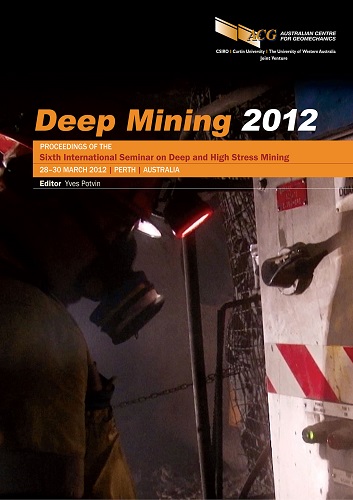Active seismic monitoring

|
Authors: Lynch, RA |
DOI https://doi.org/10.36487/ACG_rep/1201_14_lynch
Cite As:
Lynch, RA 2012, 'Active seismic monitoring', in Y Potvin (ed.), Deep Mining 2012: Proceedings of the Sixth International Seminar on Deep and High Stress Mining, Australian Centre for Geomechanics, Perth, pp. 201-210, https://doi.org/10.36487/ACG_rep/1201_14_lynch
Abstract:
The use of controlled sources of seismic radiation can facilitate a better understanding of the rock mass response to mining. Ideally, the seismic sources should be highly repeatable so that differences in seismic transmission over time can be more easily studied and related to mining. Field trials of such a seismic source at El Teniente Mine (Chile) and Mponeng Mine (South Africa) have shown that massive stacking can be used to provide useful signal-to-noise ratios despite normal mining noises, on hourly time scales. The maximum range tested here is 200 m between source and receiver, using a 5 hour data set. Seismic velocity variations can be estimated on an hourly basis, to an accuracy of not less than 10-4. The technique appears sensitive enough to detect changes in stress caused by blasting 100 m away from the source-sensor ray. Significant S-wave radiation has also been recorded from the isotropic seismic source, and is most likely the result of P-S conversion at the borehole wall. The limitations of analogue cable length between source and sensor, as well as the awkwardly large datasets, have been overcome by an automatic pre-stacking algorithm within the seismic station, as demonstrated at Ridgeway mine (Australia). Pre-stacking reduces the amount of recorded data by a factor 300, to about 80 MB/sensor/day.
References:
Birch, F. (1960) The velocity of compressional waves in rocks to 10 kilobars, part 1, in Journal of Geophysical Research, Vol. 65,
pp. 1083–1102.
Birch, F. (1961) The velocity of compressional waves in rocks to 10 kilobars, part 2, in Journal of Geophysical Research, Vol. 66,
pp. 2199–2224.
Boadu, F.K. and Long, L.T. (1996) Effects of fractures on seismic-wave velocity and attenuation, in Geophysical Journal International, Vol. 127, pp. 86–110.
Crampin, S. and Zatsepin, S.V. (1997) Modeling the compliance of crustal rock II – Response to temporal changes before earthquakes, in Geophysical Journal InternationalVol. 129, pp. 495–506.
De Fazio, T.L., Aki, K. and Alba, J. (1973) Solid earth tide and observed change in the in situ seismic velocity, in Journal of Geophysical Research, Vol.78, pp. 1319–1322.
Gladwin, M.T. (1977) Simultaneous Monitoring of Stress and Strain in Massive Rock, Pageoph Vol., p. 115.
Harris, J. (2011) In-mine rock mass characterisation using Active Seismic Monitoring, BSc (Hons) thesis, University of Tasmania.
Hudson, J.A. (1981) Wave speeds and attenuation of elastic waves in material containing cracks, in Geophysical Journal International, Vol. 64, pp. 133–150.
Leary, P.C., Malin, P.E., Phinny, R.A., Brocher, T. and Voncolln, R. (1979) Systematic monitoring of millisecond travel time variations near Palmdale, California, in Journal of Geophysical Research, Vol. 84, pp. 659–666.
Lynch, R.A. (2010) Passive and Active Seismic Monitoring in Mines, keynote address at Deep and High Stress Mining Seminar 2010, Santiago, Chile.
Niu, F., Silver, P.G., Daley, T.M., Cheng, X. and Majer, E.L. (2008) Preseismic velocity changes observed from active source monitoring at the Parkfield SAFOD drill site, in Nature, Vol. 454, 10 July 2008.
Nur, A. (1971) Effects of stress on velocity anisotropy in rocks with cracks, in Journal of Geophysical Research, Vol.76,
pp. 2022–2034.
Nur, A. and Simmons, G. (1969) The effect of saturation on velocity in low porosity rocks, Earth Planetetary Science Letters, Vol. 7, pp. 183–193.
Ogasawara, H., Sato, S., Nishii, S., Sumitomo, N., Ishii, H., Iio, Y., Nakao, S., Ando, M., Takano, M., Nagai, N., Ohkura, T., Kawakata, H., Satoh, T., Kusunose, K., Cho, A., Mendecki, A.J., Cichowicz, A., Green, R.W.E. and Kataka, M.O. (2002) Semi-controlled experiments in South African deep gold mines, The Journal of the South African Institute of Mining and Metallurgy, May/June 2002, pp. 243–250.
Reasenberg, P. and Aki, K. (1974) A precise, continuous measurement of seismic velocity for monitoring in situ stress, in Journal of Geophysical Research, Vol. 79, pp. 399–406.
Sano, O., Hieda, K., Hirano, K., Hirano, T., Ishii, H., Hirata, Y., Matsumoto, Y.S. and Yamauchi, T. (1999) Stress-sensitivity of the sound velocity at Kamaishi mine, paper presented at Seismological Society of Japan 1999 Fall Meeting, Sendai, Japan, 1999.
Scholz, C.H. (1968) Microfracturing and the inelastic deformation of rock, I: Compression in Journal of Geophysical Research, Vol. 73, pp. 1417–1432.
Silver, P.G., Daley, T.M., Niu, F. and Majer, E.L. (2007) Active source monitoring of crosswell seismic traveltime for stress-induced changes, in Bulletin of the Seismological Society of America, Vol. 97, pp. 281–293 (2007).
Walsh, J.B. (1965) The effect of cracks on the compressibility of rock, in Journal of Geophysical Research, Vol.70, pp. 381–389.
Yamamura, K., Sano, O., Utada, H., Takei, Y., Nakao, S. and Fukao, Y. (2003) Long-term observation of in situ seismic velocity and attenuation, in Journal of Geophysical Research, Vol.108, No. B6, 2317 p.
Yukutake, H., Nakajima, T. and Doi, K. (1988) In situ measurements of elastic wave velocity in a mine, and the effects of water and stress on their variation, in Tectonophysics, Vol. 149, pp. 165–175.
© Copyright 2025, Australian Centre for Geomechanics (ACG), The University of Western Australia. All rights reserved.
View copyright/legal information
Please direct any queries or error reports to repository-acg@uwa.edu.au
View copyright/legal information
Please direct any queries or error reports to repository-acg@uwa.edu.au